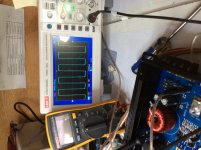These are 17mm diameter and 25mm long 200v
The originals was 14mm diameter and 25mm long, and 100v.
The originals was 14mm diameter and 25mm long, and 100v.
Test with those but if you don't see a lot of noise on the speaker output and they run hot, I think I'd try a different cap.
Customer called couple hours after, same thing with the amp...caps blew.
Whet could possibly wrong with that amp?
Whet could possibly wrong with that amp?
Is this the second repair failed?
Are you testing as suggested?
When I was doing repairs, most all class D amps were run into intermittent clipping with music for about 3 hours. I always had other things to do and did them while amps were burning in.
Are you testing as suggested?
When I was doing repairs, most all class D amps were run into intermittent clipping with music for about 3 hours. I always had other things to do and did them while amps were burning in.
Yes second repair failed.
I tested with audio couple minutes caps felt warmish, my PS is only 6amps to beging with.
Is it that they are driving it possibly to clipping why it’s busting caps?
What are the tests I should do on it?
I tested with audio couple minutes caps felt warmish, my PS is only 6amps to beging with.
Is it that they are driving it possibly to clipping why it’s busting caps?
What are the tests I should do on it?
If the caps got warm after a few minutes, you need to look at the signal on the output terminals of the amp.
I don't know what's available to you (budget or location) for power supplies but you need to test amps more thoroughly than you can on 6 amps (75 amps an absolute minimum for medium sized class D amps). A battery may be an option. Multiple used (if budget is an issue) computer power supplies (often available for cheap from computer repair shops). A large battery charger (in conjunction with the battery) may be an option. A large battery charger on boost is risky and you would need to build a comparator to act as protection from overvoltage if/when used on boost.
I don't know what's available to you (budget or location) for power supplies but you need to test amps more thoroughly than you can on 6 amps (75 amps an absolute minimum for medium sized class D amps). A battery may be an option. Multiple used (if budget is an issue) computer power supplies (often available for cheap from computer repair shops). A large battery charger (in conjunction with the battery) may be an option. A large battery charger on boost is risky and you would need to build a comparator to act as protection from overvoltage if/when used on boost.
If you connect your scope to the speaker output, do you see a perfectly clean (sharp, fine line at about 5v/div) low frequency sine wave, even if you twist the output inductor?
What's the rail-rail oscillation frequency before the inductor?
What's the rail-rail oscillation frequency before the inductor?
This is a brand new amp I opened for comparison, as the employer is gonna exchange the previous one in the essence of time.
Scope ground on speaker minus (speaker is attached) RtoR oscillation, scope is set at 1x 200v 5us.
For speaker output I’ve seen a more triangular waveform at 1x 5v 5us.
All setting is on minimal gain, no audio input nor Rca plugged in.
This is a new amp no repairs just opened for comparison, haven’t tested the problem one as yet.
Scope ground on speaker minus (speaker is attached) RtoR oscillation, scope is set at 1x 200v 5us.
For speaker output I’ve seen a more triangular waveform at 1x 5v 5us.
All setting is on minimal gain, no audio input nor Rca plugged in.
This is a new amp no repairs just opened for comparison, haven’t tested the problem one as yet.
Attachments
- Home
- General Interest
- Car Audio
- SoundStream BXA1-7500D blown caps


